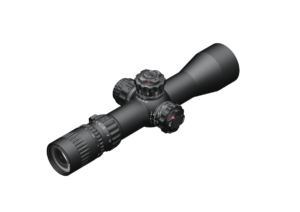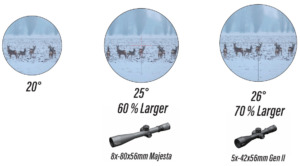Greetings!S7,
just to chime in with a consideration, just looking at the magnification and objective lens — maybe to narrow things down — maybe to muddle the waters again.....
(No. 1) March Compact 2.5-25x42
(No. 2) March Compact 2-25x52
(No. 3) March FX 1.5-15x42
(A)
Without knowing your shooting scenarios: Do you really need such a wide FoV as a 1.5x (No. 3)? Even 2x and 2.5x (No. 1 and 2) seem pretty wide by most shooting scenarios (it seems that only shooting scurrying rats at 10y range would call for such a wide FoV).
With a 3x you might have all the FoV you'll need.
(B)
For FFP scopes only: The wider the magnification range the smaller the reticle when on lower magnification.
•No. 1 has a 10-fold magnification range.
•No. 2 has a 12.5-fold magnification range.
•No. 3 has a 10-fold magnification range.
All these are fairly "extreme".
For comparison, typical magnification ranges are:
•6-24x and 4-16x have a 4-fold magni range.
•5-30x and 4-24x and 4.5-27x have a 6-fold magni range.
•2.5-20x and 3-24x and have an 8-fold magni range.
(C)
The larger the objective lens, the narrower the SPR (the sharpness and parallax range, in photography also called the DoF = depth of field). (cf. attachment below).
A narrow SPR means that for example, at a given parallax setting objects/quarry/windflags are in focus from 15y to 20y.
Whereas a wider SPR means they are in focus from 13y to 24y, for example.
Also: The higher the magnification in use, the narrower the SPR.
➔ Important for hunting critters that move a lot.
Your No. 2 has a larger objective lens than No. 1 and No. 3.
(D)
Your No. 1 and No. 2 have 25x top end magnification — your No. 3 only 15x.
In 15x the image of your quarry and it's killzone is aprox. 50% smaller than in 25x.
The adage "Aim small — miss small" is a good one.
For offhand shooting you won't be needing 25x. But for rested longer ranges you might want this.
I haven't heard anybody complain about having a scope with a magnification range that goes higher than needed at the time. But I HAVE heard many complain about not having enough magnification at the time when it was needed.
(E)
Your No. 2 has a larger objective lens that will permit more light (assuming all other factors being equal).
If you plan on filming through your scope, especially filming in slo-motion, you do need lots and lots of light.
Hope I didn't muddle the waters.....
Matthias
Attachment:
SCOPE Triangle #2 – to Balance High Magnification + Depth of Field (for Less Parallax) + Brightness
View attachment 311285
As PDF File:
View attachment 311284
I don’t mind the data at all. I don’t quite (yet) understand every single thing you said, but you got me thinking. For instance, at my beginner’s stage of scope stuff, I am only recently even considering FOV. To assist those who are trying to assist me, and to respond to your inquiry, I really only presently shoot at very humble distances: 15 or 20 feet to maybe 125 or so feet. I admitted in a previous post that I am really in over my head and out of my league with items like March scopes. But I like them.
I am not quite sure what you meant in bullet “A.” Are you saying that lower-end magnification equates to more FOV?
Next, I am trying to understand the parallax comments in bullet “C” with reference to the 42mm and 52mm objectives. Unless your distance measurements refer to width and not length; if they do, I got it.
I believe I get the rest. Also, I will check out the link, etc. when I have a bit sharper brain.
Thanks. S7
Edit: And one more thing: Scope number two is 2.5-25x52 and not 2-25x52. That was a typo.
Last edited:
Upvote 0


